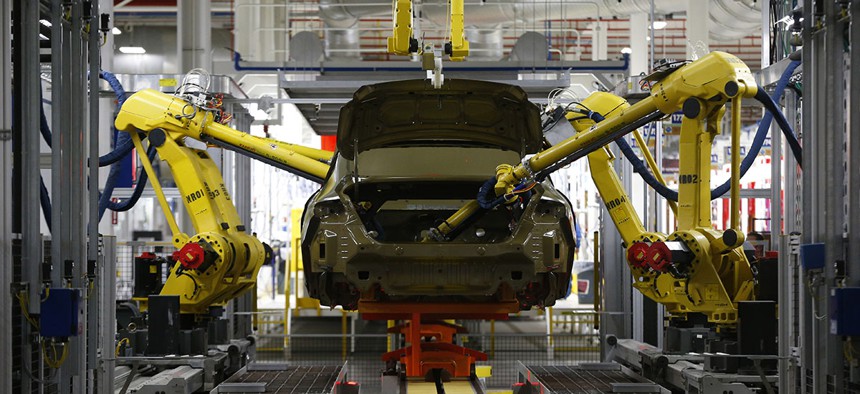A Rogue Robot is Blamed For Human Colleague’s Gruesome Death

Automated robots build a 2015 Chrysler 200 at the Sterling Heights Assembly Plant in Sterling Heights, Mich. Paul Sancya/AP File Photo
Usually when people worry about machines and work, they are concerned automation will take away their livelihoods, not their lives.
Usually when people worry about machines and work, they are concerned automation will take away their livelihoods, not their lives. But a new lawsuit claiming a rogue robot is responsible for killing a human colleague reveals additional nightmarish possibilities.
In July 2015, Wanda Holbrook, a maintenance technician performing routine duties on an assembly line at Ventra Ionia Main, an auto-parts maker in Ionia, Michigan, was “trapped by robotic machinery” and crushed to death. On March 7, her husband, William Holbrook, filed a wrongful death complaint in Michigan federal court, naming five North American robotics companies involved in engineering and integrating the machines and parts used at the plant: Prodomax, Flex-N-Gate, FANUC, Nachi and Lincoln Electric.
Holbrook’s job involved keeping robots in working order. She routinely inspected and adjusted processes on the assembly line at Ventra, which makes bumpers and trailer hitches. One day, Holbrook was performing her regular duties when a machine acted very irregularly, according to the lawsuit reported in Courthouse News.
Holbrook was in the plant’s six-cell “100 section” when a robot unexpectedly activated, taking her by surprise. The cells are separated by safety doors and the robot should not have been able to move. But it somehow reached Holbrook, and was intent on loading a trailer-hitch assembly part right where she stood over a similar part in another cell.
The machine loaded the hardware onto Holbrook’s head. She was unable to escape, and her skull was crushed. Co-workers who eventually noticed that something seemed amiss found Holbrook dead.
“The robot from section 130 should have never entered section 140, and should have never attempted to load a hitch assembly within a fixture that was already loaded with a hitch assembly. A failure of one or more of defendants’ safety systems or devices had taken place, causing Wanda’s death,” the lawsuit alleges.
William Holbrook seeks an unspecified amount of damages, arguing that before her gruesome death, his wife “suffered tremendous fright, shock and conscious pain and suffering.” He also names three of the defendants—FANUC, Nachi and Lincoln Electric—in two additional claims of product liability and breach of implied warranty. He argues the robots, tools, controllers and associated parts were not properly designed, manufactured or tested, and not fit for use.
“At all relevant times, technically feasible alternative design and engineering practices were available that could have prevented the harm without significantly impairing the usefulness or desirability of the automation system to users and without creating equal or greater risk of harm to others,” Holbrook’s family argues.
According to the Labor Department's Occupation Safety and Health Administration, robots are “generally used to perform unsafe, hazardous, highly repetitive and unpleasant tasks.” But despite any potential safety advantages, OSHA writes, “studies indicate that many robot accidents occur during non-routine operating conditions, such as programming, maintenance, testing, setup, or adjustment. During many of these operations the worker may temporarily be within the robot’s working envelope where unintended operations could result in injuries.”
There are currently no specific safety standards for the robotics industry. As of 2014, OSHA reported about 30 robotics-related deaths over a period of 30 years. But as The New York Times noted, the machine-inflicted death toll will likely rise as robots are increasingly engineered to be mobile, autonomous and working freely alongside humans.
NEXT STORY: The Optimist’s Guide to the Robot Apocalypse





